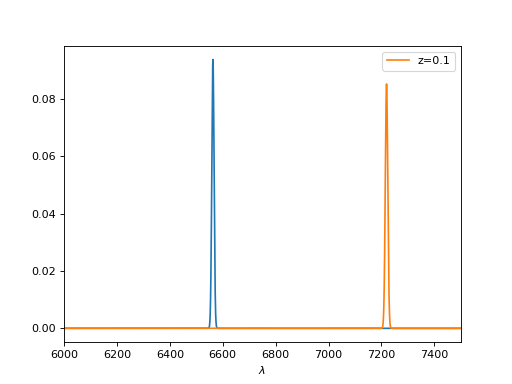SpectrumTemplate¶
- class grizli.utils.SpectrumTemplate(wave=None, flux=None, central_wave=None, fwhm=None, velocity=False, fluxunits=Unit('erg / (Angstrom s cm2)'), waveunits=Unit('Angstrom'), name='template', lorentz=False, err=None)[source]¶
Bases:
objectContainer for template spectra.
- Parameters
- wavearray-like
Wavelength In
astropy.units.Angstrom.- fluxfloat array-like
If float, then the integrated flux of a Gaussian line. If array, then f-lambda flux density.
- central_wave, fwhmfloat
Initialize the template with a Gaussian at this wavelength (in
astropy.units.Angstrom.) that has an integrated flux offluxandfwhminastropy.units.Angstromorkm/sforvelocity=True.- velocitybool
fwhmis a velocity inkm/s.
Examples
import matplotlib.pyplot as plt from grizli.utils import SpectrumTemplate ha = SpectrumTemplate(central_wave=6563., fwhm=10) plt.plot(ha.wave, ha.flux) ha_z = ha.zscale(0.1) plt.plot(ha_z.wave, ha_z.flux, label='z=0.1') plt.legend() plt.xlabel(r'$\lambda$') plt.xlim(6000, 7500) plt.show()
(
Source code,png,hires.png,pdf)
- Attributes
- wave, fluxarray-like
Passed from the input parameters or generated/modified later.
Methods
__add__, __mul__
(Addition and multiplication of templates.)
Attributes Summary
Convert to
eazy.template.TemplateobjectMethods Summary
integrate_filter(filter[, abmag, use_wave])Integrate the template through an
FilterDefinitionfilter object.make_gaussian(central_wave, fwhm[, ...])Make Gaussian template
to_fnu([fnu_units])Make fnu version of the template.
zscale(z[, scalar, apply_igm])Redshift the template and multiply by a scalar.
Attributes Documentation
- eazy¶
Convert to
eazy.template.Templateobject
Methods Documentation
- integrate_filter(filter, abmag=False, use_wave='filter')[source]¶
Integrate the template through an
FilterDefinitionfilter object.- Parameters
- filter
ObsBandpass Or any object that has
waveandthroughputattributes, with the former in the same units as the input spectrum.- abmagbool
Return AB magnitude rather than fnu flux
- filter
- Returns
- temp_fluxfloat
Examples
Compute the WFC3/IR F140W AB magnitude of a pure emission line at the 5-sigma 3D-HST line detection limit (5e-17 erg/s/cm2):
>>> import numpy as np >>> from grizli.utils import SpectrumTemplate >>> from eazy.filters import FilterDefinition >>> import pysynphot as S >>> line = SpectrumTemplate(central_wave=1.4e4, fwhm=150., velocity=True)*5.e-17 >>> filter = FilterDefinition(bp=S.ObsBandpass('wfc3,ir,f140w')) >>> fnu = line.integrate_filter(filter) >>> print('AB mag = {0:.3f}'.format(-2.5*np.log10(fnu)-48.6)) AB mag = 26.619
- static make_gaussian(central_wave, fwhm, max_sigma=5, step=0.1, wave_grid=None, velocity=False, clip=1e-06, lorentz=False)[source]¶
Make Gaussian template
- Parameters
- central_wave, fwhmNone or float or array-like
Central wavelength and FWHM of the desired Gaussian
- velocitybool
fwhmis a velocity.- max_sigma, stepfloat
Generated wavelength array is
>>> rms = fwhm/2.35 >>> xgauss = np.arange(-max_sigma, max_sigma, step)*rms+central_wave
- clipfloat
Clip values where the value of the gaussian function is less than
cliptimes its maximum (i.e.,1/sqrt(2*pi*sigma**2)).- lorentzbool
Make a Lorentzian line instead of a Gaussian.
- Returns
- wave, fluxarray-like
Wavelength and flux of a Gaussian line
- to_fnu(fnu_units=Unit('erg / (Hz s cm2)'))[source]¶
Make fnu version of the template.
Sets the
flux_fnuattribute, assuming that the wavelength is given in Angstrom and the flux is given in flambda:>>> flux_fnu = self.flux * self.wave**2 / 3.e18
- zscale(z, scalar=1, apply_igm=True)[source]¶
Redshift the template and multiply by a scalar.
- Parameters
- zfloat
Redshift to use.
- scalarfloat
Multiplicative factor. Additional factor of 1./(1+z) is implicit.
- Returns
- new_spectrum
SpectrumTemplate Redshifted and scaled spectrum.
- new_spectrum